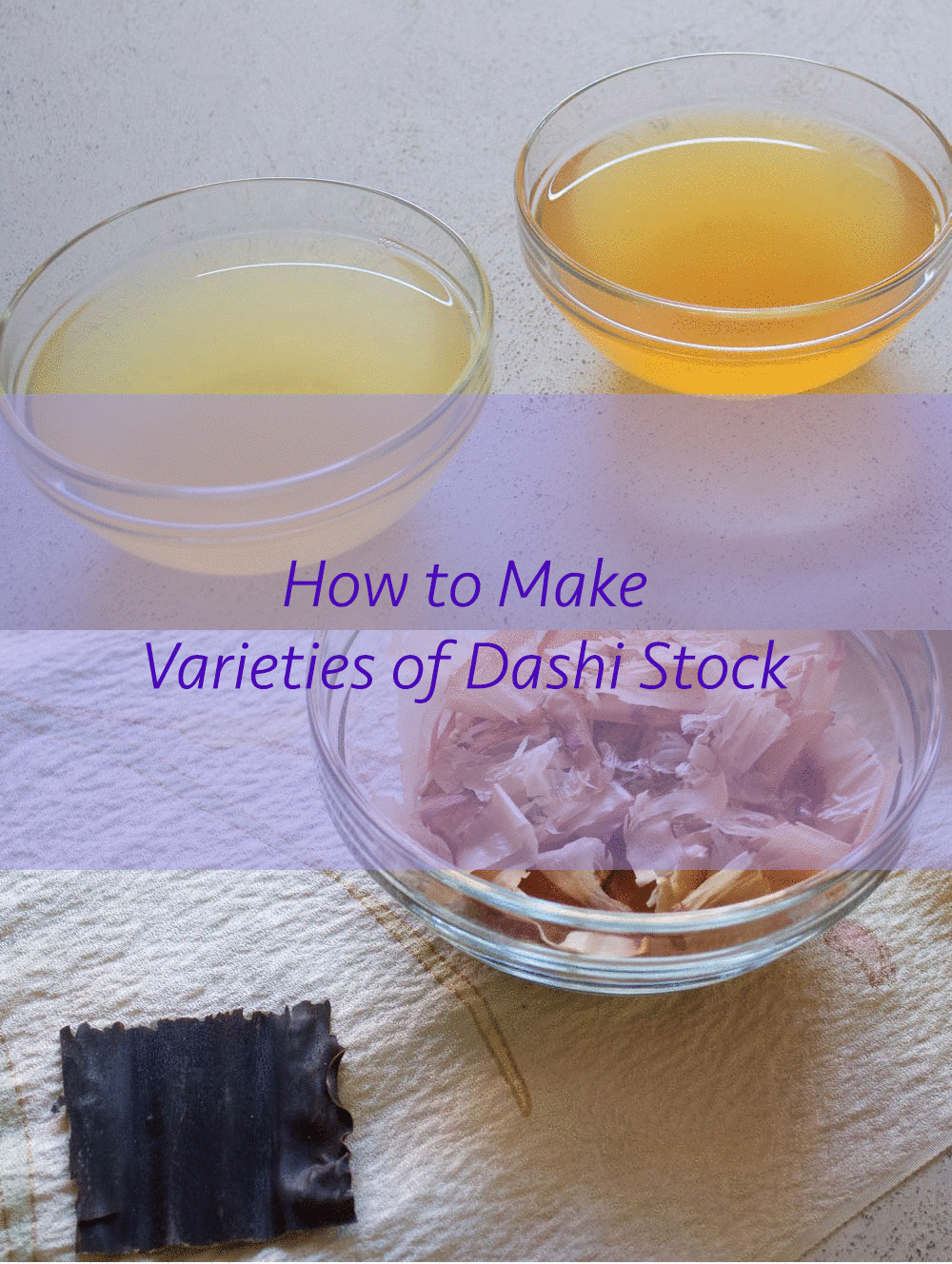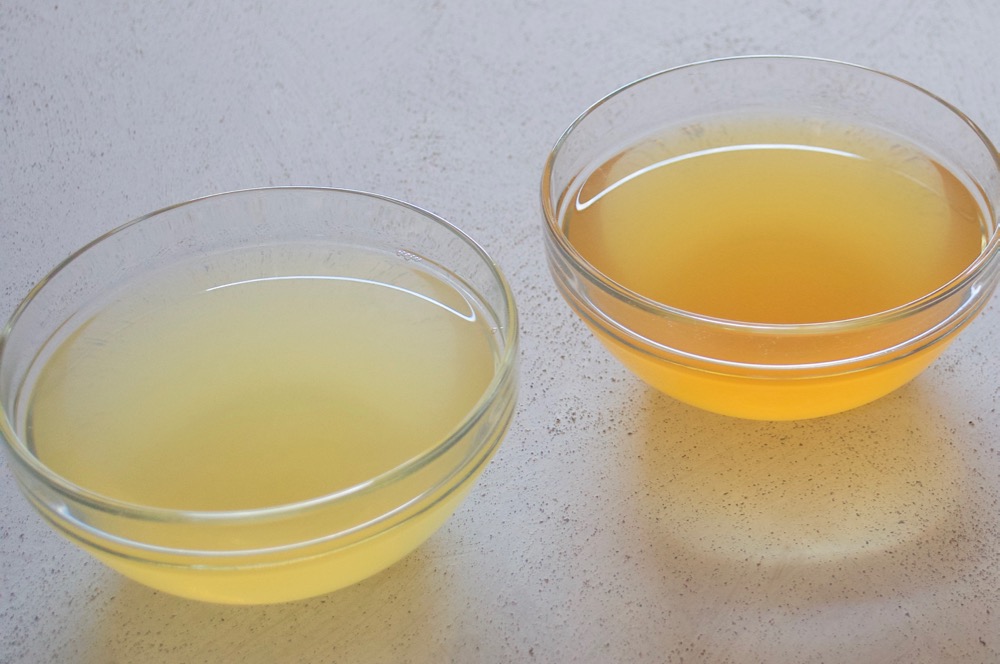In this post, I would like to introduce to you different kinds of Japanese dashi stock. They all have totally different flavours and some of them are vegetarian. I posted the commonly used method of making dashi stock in Home Style Japanese Dashi Stock, but it is good to know the different methods for you to try out.

Depending on the dishes you are making, you use different kinds of dashi (出汁)stock. The following are the main varieties of Japanese dashi stock.
- Awase-dashi (合わせ出汁) – made from katsuobushi (鰹節, dried bonito flakes) and konbu (dried kelp)
- Katsuo-dashi (鰹出汁) – made from katsuobushi (鰹節, dried bonito flakes) only
- Konbu-dashi (昆布出汁) – made from konbu(昆布, dried kelp)
- Niboshi-dashi (煮干し出汁) – made from niboshi (煮干し, small dried sardines/anchovies)
- Shiitake-dashi (椎茸出汁) – made from dried shiitake(椎茸) mushrooms
In the case of awase-dashi and katsuo-dashi, after making stock from the above ingredients, you can make another batch of dashi stock by reusing the ingredients. The first dashi stock is called ichiban-dashi (一番出汁) and the second stock is niban-dashi (二番出汁). The word ichiban/niban means number 1 and 2 respectively in Japanese.
In general, ichiban-dashi mostly used for osuimono (お吸い物, Clear Soup) or lightly flavoured dish as the flavour of the soup is what you are meant to enjoy. I like ichiban-dashi made from awase-dashi best as it has really good flavour.
In the post, Home Style Japanese Dashi Stock I introduced a recipe for the most commonly used dashi at home. Homemade dashi is awase-dashi but instead of getting first and second strains of dashi stock, you strain only once.

Here are the recipes for the different kinds of dashi stocks. All of them are quite simple to make. Some of them are vegetarian and vegan too.
Awase-dashi, Ichiban-dashi
- 500ml water
- 5cm x 5cm (2 inch x 2 inch) strip of Konbu (dried kelp)
- 15g (0.5 oz) Katsuobushi (dried bonito flakes)
- Gently wipe any dust off konbu if necessary using dry towel or paper towel. Do not wash or remove white powder stuck on the surface of konbu by scraping it off as it is the umami (旨味).
- Add the water in a pot and soak the konbu for about 30 minutes if you have time. If you don’t have time, don’t worry.
- Place the pot over medium heat. When small bubbles start appearing in the pot, remove the konbu and reserve for Nibandashi below.
- Turn the heat up and let it come to a boil. Add about 100ml of water to lower the temperature, then add katsuobushi. When the water starts boiling again, turn the heat down to minimum and simmer for a couple of minutes. Remove any scum on the surface occasionally.
- Turn the heat off and wait until the katsuobushi sinks to the bottom of the pan. Now the dashi is ready.
- Line a few layers of muslin or a paper towel in a sieve and pour all the contents in the pan into the sieve. Let it drain naturally. Do not squeeze the katsuobushi or the stock will loose clarity. Reserve the katsuobushi for Niban-dashi (below).
Suitable for osuimono (clear soup), and lightly flavoured dishes.
Awase-dashi, Niban-dashi
- 500ml water
- Leftover katsuobushi and konbu from ichiban-dashi
- 5g (0.2 oz) Katsuobushi (dried bonito flakes)
- Add the water and the leftover katsuobushi and konbu from ichiban-dashi to a pot over high heat.
- Once it starts boiling, turn the heat down to low and simmer for 10 minutes.
- Add the katsuobushi and turn the heat off.
- Wait until the bonito flakes sinks onto the bottom of the pan, then strain as per ichiban-dashi method. Squeeze the katsuobushi lightly to get out the juice.
Suitable for Miso soup, general cooking.
Niboshi-dashi
- 500ml water
- 20g (0.7 oz) Niboshi (dried anchovies)
- Remove the head, split the body and remove the dried guts inside each fish. Discard heads and guts.
- Add water and niboshi to a pot and leave for at least 30 minutes, preferably overnight.
- Place the pot over medium heat. Boil for 5 minutes, removing any scum occasionally.
- Turn the heat off. Strain using a sieve laid with layered muslin or paper towels.
Suitable for miso soup, general cooking, particularly root vegetables.
Katsuo-dashi, Ichiban-dashi
- 500ml water
- 15g (0.5 oz) Katsuobushi (dried bonito flakes)
- Add the water to a pan and boil over high heat. Once water boils, turn off the heat.
- Add katsuobushi to the boiled water and leave for about 2 minutes.
- Using a sieve lined with layered muslin or a paper towel, drain for about one minute to ensure that as much dashi comes out. Do not squeeze katsuobushi. Reserve the katsuobushi for Niban-dashi (below).
Suitable for osuimono, chawanmushi (茶碗蒸し, savoury egg custard).
Katsuo-dashi, Niban-dashi
- 500ml water
- Leftover katsuobushi from ichiban-dashi
- 5g (0.2 oz) Katsuobushi (dried bonito flakes)
- Add the water and the leftover katsuobushi from ichiban-dashi to a pot over high heat.
- Once it starts boiling, turn the heat down to low and simmer for a few minutes.
- Add the katsuobushi and turn the heat off.
- Wait until the katsuobushi sinks to the bottom of the pan, then strain as per ichiban-dashi. Squeeze katsuobushi lightly to get out the juice.
Suitable for general cooking and miso soup.
Konbu-dashi (Vegetarian)
- 500ml water
- 10cm x 10cm (4 inch x 4 inch) strip of Konbu (dried kelp)
- Gently wipe any dust off konbu if necessary using dry towel or paper towel. Do not wash or remove white powder stuck on the surface of konbu by scraping it off as it is the umami (旨味).
- Add the water to a pot and soak the konbu for about 3 hours. In hot weather, leave it in the fridge. Set aside the konbu after soaking.
- If you don’t have time required as per step 2 above, here is the express way. Boil water in a pot. Turn off the heat and add konbu, leave for minimum 15 minutes. Remove konbu.
Suitable for vegetarian dishes, sushi rice.
Shiitake-dashi (Vegetarian)
- 500ml water
- 15g (0.5 oz) Dried shiitake mushrooms (whole, not sliced)
- Lightly rinse the shiitake to remove any dust.
- Add the shiitake to the water (cold water if possible) in a pot or a bottle/container with a lid and leave it in the fridge for minimum 6 hours, preferably 24 hours.
- Remove the shiitake.
Normally used with other dashi stock to give flavour especially when rehydrated shiitake is one of the ingredients.
You cannot keep dashi very long even in the fridge as it loses flavour. 2-3 days is the max, I would think. Freezing is also not good as it will still lose the flavour but if you don’t mind that, you could freeze the stock.
After making Dashi from konbu, shiitake or niboshi, do not discard the ingredients. You can freeze them and when accumulated enough, you can cook with other vegetables or on its own with soy sauce & mirin. I will show you a dish or two using these in my future post. In the case of konbu, I sometimes just eat it on its own as a snack.
Yumiko![]()
Hi Yumiko,
I followed your recipe on Yosenabe and it tastes GREAT!! thank you!
I have a question on making awase dashi – if I were to use thick bonito shavings (atsu kezuri) to make dashi instead of thin flakes, is the process the same? or should i simmer it longer than usual?
Thanks,
Tserlih
Hi Tserlih, in the case of atsu kezuri, you will need to simmer for 10-15 minutes, then after turning off the heat, leave for 5-10 minutes. Depending on what you use dashi stock for, you vary the simmering time. Shorter time gives you a delicate aroma of the stock, which is suited for delicate dishes like chawanmushi. Longer simmering time will make the stock with stronger umami which is best for noodle soup and miso soup.
That’s great advise – I’ll use the above steps when I try thick shavings next time. Thanks Yumiko!
I tend to leave the thin shavings in the pot longer than usual (10 to 15mins instead of 2 to 5 as often advised) after I turn off the gas. I feel this way I extract as much flavour as possible haha..